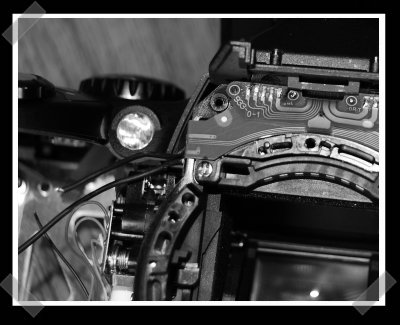
Nikon didn’t build a light metering chip into the D40. That’s fine if you’re using one of their auto lenses with the on-board chip. [Matt] decided to add a sensor to his camera and try it out with his manual lenses. His writeup is a bit challenging to get through, but if you’re really into Nikons, you’ll make it. He had to tap into the ribbon cable inside the body, mount the extra hardware, and add an additional switch outside the body to allow the chip to be turned on and off. The extra sensor adds a bit of a step to taking the shot, but it’s the sort of thing that’ll become second nature pretty quickly.
5 thoughts on “Add On-board Light Metering To Your Nikon D40”
Leave a Reply
Please be kind and respectful to help make the comments section excellent. (Comment Policy)














Nikon makes some lovely lenses but I have never really cared for their bodies. I have been thinking of getting an EF adapter to mount some of the old manual Nikkors I have on my Canon 5D, anybody know of a good quality one? They are all over eBay but I’d rather buy something a little more assuring then a cheaply milled aluminum ring from China with no guarantee it won’t get stuck on my lens or body.
@haxxorfreak
I’ve been successfully using a relatively cheap chinese one I bought from an ebay seller called Roxsen for the last 2 years. It doesn’t get very heavy use (I tend to use AF lenses for the zoom and the fact I suck at manual focussing) but I’ve never had sticking problems on either a 350D or a 20D. I’ve used it with a 135mm 2.8, a 50mm 1.8 and a 35mm 2.5 my dad used to own, all with good results. Canon do exceptionally well in this regard – an EOS + adapter can be used in Av with one of these lenses, while on a Nikon body (even something like a D300) it can only be used in manual.
Nikon started off with everything in the body when they went AF. Canon moved focussing to the lens, but kept everything else body-side. Now, Nikon are moving across to everything-in-the-lens mode. Not sure why. Canon seem to have it at about the right level of body-lens co-operation. Things like IS can’t be done very successfully in body, while metering clearly can be.
I also have a Nikon lens > EF(S) body adapter. It’s an el-cheapo off ebay. I bought it from some Hong Kong super seller with a billion or so sales. It was $14 with shipping. I’ve been using it for several months now, and it works pretty well. It allows for full infinity focus, which was a major pain in my ass with my FD lens > EF(S) body adapter. The adapter also allows you to use a shit-ton of lenses, every Nikon lens I’ve put on it has worked great. Lenses from the 70’s ’til now work fine. The distance scale on the focus ring is accurate too. The adapter also contains no glass elements, which means zero reduction of quality. I would definitely recommend getting one, I’m glad I did.
This story is slightly wrong:
The D40 has a rather advanced light meter in the body.
The problem that this hack solves, is that Nikon’s consumer cameras don’t have all the mechanical linkages to interface with the often very nice, but also very old, manual focus lenses. This means the lens will work, but the body cannot meter properly.
The more modern af lenses communicate with the body electronically and the more expensive bodies often include the mechanical bits needed to work with the old lenses.
The Nikon system has a lot of backwards compatibility built in, even though functionality might degrade a bit as the lens and camera become more mismatched. This means that all Nikon lenses made since 1959 will work on my ultra-cheap and hitech D40, except they won’t do autofocus (of course) or meter.
Compare that with Canon, where nothing made before 1987 will work at all on a modern body.
The hack itself is still pretty awsome of course :)
Since the D40 has a light sensor, and after the hack the user still must tell the camera what aperture the lens is using (like on Canon rebel XT), the real issue here seems to be Nikon’s software not allowing you to tell it the aperture.
Its very similar to the way some DSLR’s refuse to release the shutter when “no lens is attached” — or you are using a T mount lens, which does nothing to the electrical contacts. D40 menus have an override for that. All we really need is a “meter anyways” override in the software.
Maybe there is a simpler hack, involving covering or shorting some pins on the lens/camera interface…